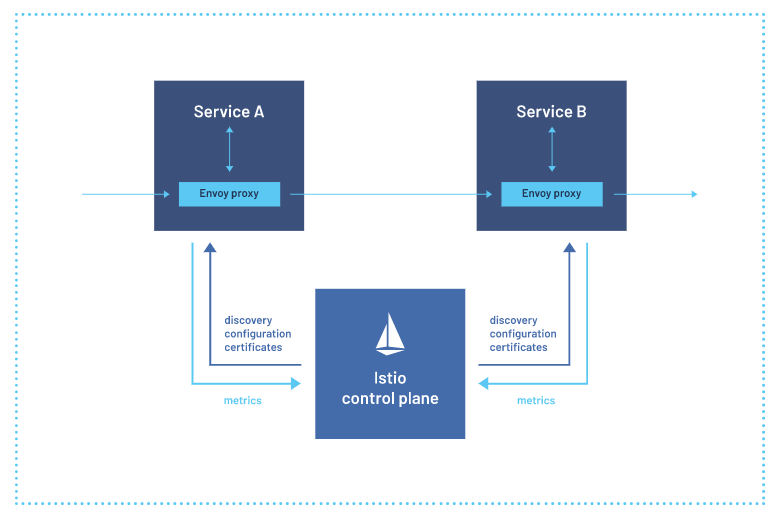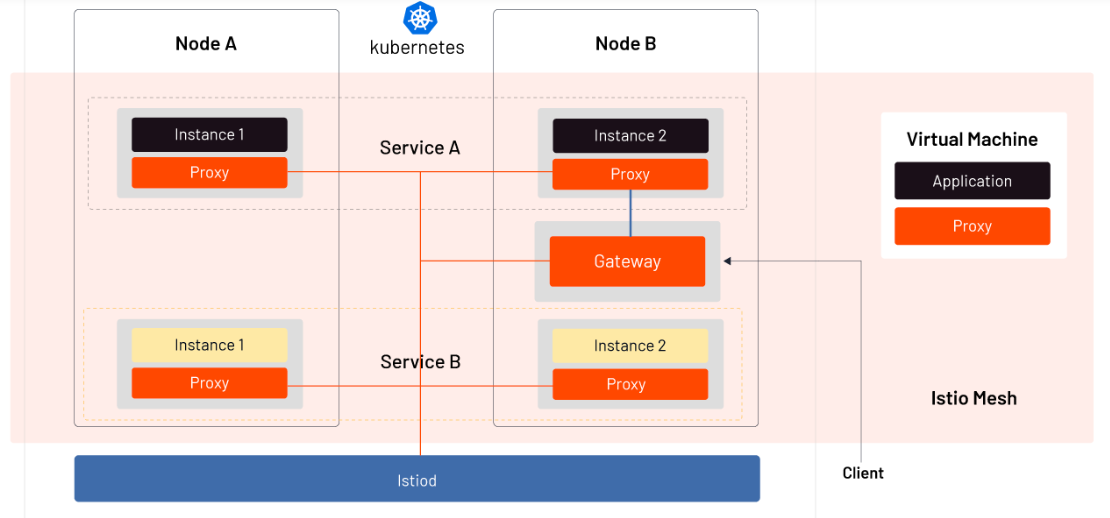
In recent years, microservices have emerged as a popular approach to building modern software applications. This approach breaks down applications into smaller, independent components, each responsible for a specific task or function. However, managing the communication between these components can be challenging, especially as the number of services grows.
This is where service meshes come in. A service mesh is a dedicated infrastructure layer that helps facilitate communication between services or microservices. It provides observability and control over the interactions between services, making it easier to manage and monitor complex microservice architectures.
This guide is intended to provide information about Istio, one of the most popular service meshes for Kubernetes, and explore its features and benefits. But first, let’s dive into service mesh to understand its role in modern software development better.
What is a Service Mesh?
A service mesh is a dedicated infrastructure layer that facilitates service-to-service communication in a microservices architecture. It provides a transparent and decentralized network for microservices to communicate with each other, handling traffic management, service discovery, load balancing, security, and observability tasks.
Service meshes help simplify the management of microservices by providing a layer of abstraction that decouples the application logic from the network and infrastructure concerns. This allows developers to focus on building business logic without worrying about the underlying communication infrastructure.
What is Istio?
Istio is an open-source service mesh platform that can be seamlessly integrated with existing distributed applications. It is designed to work with Kubernetes but can also be used with other container orchestration platforms.
Its robust features enable a consistent and effective method to secure, connect, and monitor services. With Istio, you can achieve load balancing, service-to-service authentication, and monitoring without requiring significant changes to the service code.
Moreover, the Istio service mesh automates and secures communication between microservices, providing a control plane based on lightweight network proxies. It works on various environments and allows developers to focus on business logic while platform teams manage traffic, security, and monitoring. Istio is independent of programming languages and enables cloud-native, and microservice architecture approaches.
Istio service mesh management offers the following features:
- Traffic management: Istio provides sophisticated traffic management features that allow organizations to control traffic flow between microservices, balance loads, and ensure that the right services receive the right amount of traffic.
- Security: Istio enables organizations to secure their microservices with features like mutual TLS authentication, fine-grained access control, and automatic encryption of traffic between services.
- Observability: Istio provides powerful observability features, including distributed tracing, metric collection, and log aggregation, which help organizations monitor the health and performance of their microservices.
How Does Istio Work?
Istio consists of two main components: the data and control planes.
The data plane handles communication between services. Without a service mesh, the network has no understanding of the traffic and cannot make informed decisions based on the traffic type or the traffic’s source and destination.
To address this, Istio uses a proxy that intercepts all network traffic, providing application-aware features based on the configuration you set. Each service in your cluster has an Envoy proxy deployed alongside it or services running on VMs.
The control plane takes the desired configuration and service information and dynamically updates the proxy servers. As the rules or environment changes, the control plane adjusts the proxies to reflect the changes.
Before utilizing Istio

After utilizing Istio

Benefits of Using Istio Mesh Service
Istio service mesh offers significant advantages for organizations with microservices-based applications at scale. As traffic between microservices grows, the demand for advanced routing and secure data flow increases exponentially. Some benefits of using Istio service mesh include:
- Increased Focus
Istio service mesh abstracts the communication layer and network infrastructure, allowing developers to concentrate on creating value through their services rather than being concerned with service-to-service communication. This increased focus on business logic can result in higher developer productivity and faster time-to-market for new features.
- Compliance with Standards
Istio service mesh enables engineering and platform teams to establish security and compliance policies and verify that their applications and infrastructure align with industry standards such as FedRAMP, PCI, and GDPR compliance.
- Improved Performance
Istio service mesh offers capabilities such as canary and blue-green deployment, which DevOps teams can easily implement through runtime traffic splitting. This enables organizations to gain valuable insights into how their applications are being consumed by specific audiences, allowing them to optimize performance and enhance the user experience.
- Secured Communication
By abstracting the network layer, Istio service mesh simplifies the implementation of service-to-service security for security operators. This includes features like authentication, authorization, and encryption, which can be easily implemented using mutual TLS (mTLS) connections. This makes it easier to ensure secure communication between microservices within an organization.
What is Istio Used for?
Istio simplifies the management of distributed applications and enables organizations to perform service-to-service network operations like traffic management, authorization, encryption, auditing, and observability. These benefits of Istio are realized through various use cases, which include:
- Strengthen the security of cloud-native apps: Protect your applications with strong identity-based authentication, authorization, and encryption at the application level.
- Efficient traffic management: Have granular control over traffic behavior with powerful routing rules, retries, failovers, and fault injection.
- Monitor the service mesh: Gain in-depth insights into the impact of service performance upstream by leveraging Istio’s robust monitoring, tracing, and logging capabilities.
- Simplify deployment with Kubernetes and virtual machines: Benefit from Istio’s network controls and visibility, whether you are using traditional workloads or modern ones like containers and virtual machines.
- Streamline load balancing with advanced features: Optimize your traffic with automated load balancing and features such as client-based routing and canary rollouts.
- Implement policies effectively: Enforce policies by leveraging Istio’s pluggable policy layer and configuration API, which supports access controls, rate limits, and quotas.
How is Istio used in Kubernetes?
Kubernetes has the capability to create multiple instances of a service on different nodes to distribute the workload. Service objects are used to tag all instances of the same service in Kubernetes. (Learn about Kubernetes Architecture)
However, the Kube proxy and Ingress proxy in Kubernetes only offer basic traffic management features, unable to handle complex traffic splitting and guarantee network security and compliance.
To address this, organizations can leverage Istio to handle advanced network functions and security for Kubernetes workloads and clusters spanning multiple data centers. One key difference between the Kube proxy and Istio is that the former only serves as a Layer 4 proxy, while the latter works as both Layer 4 and Layer 7 proxy in the OSI layer.
Istio utilizes a control plane called Istiod to manage traffic between Kubernetes workloads, VMs, and services in a cluster. Its architecture diagram illustrates how Istio handles client traffic and communication between services in

How to Deploy Istio?
To start using Istio, you can download it from community repositories on GitHub or acquire it from a commercial provider. The control plane of Istio is then deployed in Kubernetes clusters with Envoy Proxy gateways and sidecars, allowing you to manage policies for both North-South and East-West traffic.
Customers can install Istio using Helm charts or YAML files in Kubernetes and use the Istio control plane to manage configurations, set policies, and perform updates. The Istio command line tool “istioctl” is often used to define and implement configurations and changes programmatically. Envoy proxies are set up as sidecars in each Kubernetes application cluster once Istio is deployed and configured.
Managing Istio requires significant administrative effort and investment to meet enterprise requirements. Alternatively, you can choose a more comprehensive Istio management product like Gloo Mesh, which includes enterprise production support. An Istio-native developer portal can make it easier for API-producing and consuming developers, enabling GitOps and CI/CD methodologies.
Leverage the Power of Microservices with Taikun
Istio service mesh is a powerful tool for managing microservices-based applications, providing advanced features like traffic management, security, and observability. However, as your container infrastructure grows, managing hundreds of containers across multiple cloud environments can quickly become complex and expensive.
That’s where Taikun by Itera.io comes in. Taikun offers a cloud-based central management console and monitoring dashboard that can work seamlessly across private, public, and hybrid cloud environments with most major cloud providers. With Taikun, you can remotely manage all your container deployments, create new ones, and destroy old ones with just a few clicks while optimizing your use of containers on different cloud deployments.
By leveraging Taikun, you can take your microservices-based applications to the next level, all while reducing the burden of managing your container infrastructure.


